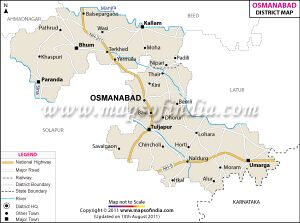Dharashiv
| Author:Laxman Burdak, IFS (Retd.) |

Dharashiv Caves (धारसिव) are the nexus of 7 caves located 8 km away from Osmanabad/Usmanabad city in Balaghat mountains in Maharashtra state of India.[1]
Contents
Variants
History
The caves were taken note by Archaeological Department of India and mentioned in the book Archaeological survey of India by James Burges.[2] Dharashiv Caves have been declared as Protected area by Government of Maharashtra.
Dharashiv caves are believed to be built around 5th-7th century. First cave has been discovered in 10th century during the age of Rashtrakutas, while there have been debates over caves whether they are Buddhist or Jain creations. It is believed that these caves were originally Buddhist, but were later converted into monuments of the Jain religion.[3]
There are 7 caves, 1st cave is harnessed by 20 pillars of scaffolding. Cave No. 2 is among major caves and modeled on the plan of the Vakataka caves atAjanta. It has a central hall measuring 80 feet by 80 feet, with 14 cells for the residence of the Bhiksus and garbhagraha with a statue of the Gautam Buddha in Padmasana. 3rd cave resembles with 1st, while later caves are Jain caves.[4]
Dharashiv caves are claimed by both Buddhist and Jain traditions. However research done by James Burges on 1200 caves in Maharashtra state showed that Dharashiv caves were originally a Buddhists caves in 5th century AD, while in 12th century some caves were converted to Jain caves.[5]
धारसिव
धारसिव (महाराष्ट्र) (AS, p.466) : धारासिव महाराष्ट्र में स्थित एक ऐतिहासिक स्थान है। यह स्थान अपने प्राचीन शैलकृत गुहा मंदिरों के लिए विशेष रूप से उल्लेखनीय है।[6]
धरसेव
धरसेव (जिला उस्मानाबाद, महाराष्ट्र) (AS, p.463): धरसेव महाराष्ट्र राज्य के उस्मानाबाद नगर के पास स्थित है। धरसेव पर डाबरलेण, चमरलेण और लचंदरलेण नाम के प्राचीन जैन और वैष्णव गुफाएँ स्थित हैं, जिनका समय 500 ई. से 600 ई. तक माना गया है। 14 वीं शती की शमसुद्दीन की दरगाह भी यहाँ है। [7]
References
- ↑ http://www.osmanabadonline.in/city-guide/dharashiv-caves ]
- ↑ "Dharashiv Caves - Historical Background". Official Government website of Osmanabad
- ↑ "Dharashiv Caves - Historical Background". Official Government website of Osmanabad
- ↑ "Dharashiv Caves - Historical Background". Official Government website of Osmanabad
- ↑ http://ekpravas.blogspot.in/2011/08/dharashiv-caves.html
- ↑ Aitihasik Sthanavali by Vijayendra Kumar Mathur, p.466
- ↑ Aitihasik Sthanavali by Vijayendra Kumar Mathur, p.463